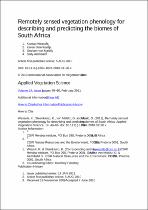 ResearchSpace
ResearchSpace
Remotely sensed vegetation phenology for describing and predicting the biomes of South Africa
JavaScript is disabled for your browser. Some features of this site may not work without it.
- ResearchSpace
- →
- Research Publications/Outputs
- →
- Journal Articles
- →
- View Item
| dc.contributor.author |
Wessels, Konrad J

|
|
| dc.contributor.author |
Steenkamp, Karen C

|
|
| dc.contributor.author |
Von Maltitz, Graham P

|
|
| dc.contributor.author |
Archibald, S

|
|
| dc.date.accessioned | 2011-11-15T08:03:23Z | |
| dc.date.available | 2011-11-15T08:03:23Z | |
| dc.date.issued | 2011-02 | |
| dc.identifier.citation | Wessels, K.J., Steenkamp, K.C., Von Maltitz, G.P. and Archibald, S. 2011. Remotely sensed vegetation phenology for describing and predicting the biomes of South Africa. Applied Vegetation Science, vol 14(1), pp 49–66 | en_US |
| dc.identifier.issn | 1402-2001 | |
| dc.identifier.uri | http://onlinelibrary.wiley.com/doi/10.1111/j.1654-109X.2010.01100.x/abstract | |
| dc.identifier.uri | http://hdl.handle.net/10204/5285 | |
| dc.description | Copyright: Wiley Blackwell 2011. ABSTRACT ONLY | en_US |
| dc.description.abstract | What are the patterns of remotely sensed vegetation phenology, including their inter-annual variability, across South Africa? What are the phenological attributes that contribute most to distinguishing the different biomes? How well can the distribution of the recently redefined biomes be predicted based on remotely sensed, phenology and productivity metrics? Ten-day, 1 km, NDVI AVHRR were analysed for the period 1985 to 2000. Phenological metrics such as start, end and length of the growing season and estimates of productivity, based on small and large integral (SI, LI) of NDVI curve, were extracted and long-term means calculated. A random forest regression tree was run using the metrics as the input variables and the biomes as the dependent variable. A map of the predicted biomes was reproduced and the differentiating importance of each metric assessed. Regression tree analysis based on remotely sensed metrics performed as good as, or better than, previous climate-based predictors of biome distribution. The results confirm that the remotely sensed metrics capture sufficient functional diversity to classify and map biome level vegetation patterns and function. | en_US |
| dc.language.iso | en | en_US |
| dc.publisher | Wiley-Blackwell | en_US |
| dc.relation.ispartofseries | Workflow request;5377 | |
| dc.subject | AVHRR | en_US |
| dc.subject | Biomes | en_US |
| dc.subject | NDVI | en_US |
| dc.subject | Net primary production | en_US |
| dc.subject | Phenology | en_US |
| dc.subject | Regression tree | en_US |
| dc.subject | Vegetation mapping | en_US |
| dc.title | Remotely sensed vegetation phenology for describing and predicting the biomes of South Africa | en_US |
| dc.type | Article | en_US |
| dc.identifier.apacitation | Wessels, K. J., Steenkamp, K. C., Von Maltitz, G. P., & Archibald, S. (2011). Remotely sensed vegetation phenology for describing and predicting the biomes of South Africa. http://hdl.handle.net/10204/5285 | en_ZA |
| dc.identifier.chicagocitation | Wessels, Konrad J, Karen C Steenkamp, Graham P Von Maltitz, and S Archibald "Remotely sensed vegetation phenology for describing and predicting the biomes of South Africa." (2011) http://hdl.handle.net/10204/5285 | en_ZA |
| dc.identifier.vancouvercitation | Wessels KJ, Steenkamp KC, Von Maltitz GP, Archibald S. Remotely sensed vegetation phenology for describing and predicting the biomes of South Africa. 2011; http://hdl.handle.net/10204/5285. | en_ZA |
| dc.identifier.ris | TY - Article AU - Wessels, Konrad J AU - Steenkamp, Karen C AU - Von Maltitz, Graham P AU - Archibald, S AB - What are the patterns of remotely sensed vegetation phenology, including their inter-annual variability, across South Africa? What are the phenological attributes that contribute most to distinguishing the different biomes? How well can the distribution of the recently redefined biomes be predicted based on remotely sensed, phenology and productivity metrics? Ten-day, 1 km, NDVI AVHRR were analysed for the period 1985 to 2000. Phenological metrics such as start, end and length of the growing season and estimates of productivity, based on small and large integral (SI, LI) of NDVI curve, were extracted and long-term means calculated. A random forest regression tree was run using the metrics as the input variables and the biomes as the dependent variable. A map of the predicted biomes was reproduced and the differentiating importance of each metric assessed. Regression tree analysis based on remotely sensed metrics performed as good as, or better than, previous climate-based predictors of biome distribution. The results confirm that the remotely sensed metrics capture sufficient functional diversity to classify and map biome level vegetation patterns and function. DA - 2011-02 DB - ResearchSpace DP - CSIR KW - AVHRR KW - Biomes KW - NDVI KW - Net primary production KW - Phenology KW - Regression tree KW - Vegetation mapping LK - https://researchspace.csir.co.za PY - 2011 SM - 1402-2001 T1 - Remotely sensed vegetation phenology for describing and predicting the biomes of South Africa TI - Remotely sensed vegetation phenology for describing and predicting the biomes of South Africa UR - http://hdl.handle.net/10204/5285 ER - | en_ZA |





